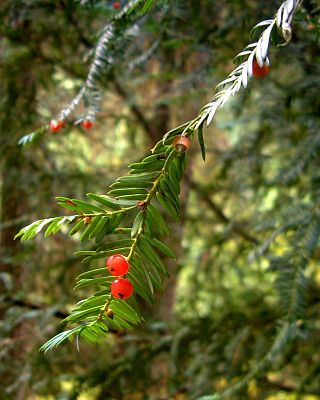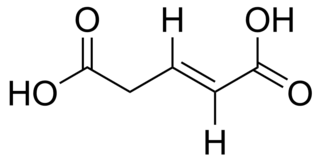
In organic chemistry, an amide, also known as an organic amide or a carboxamide, is a compound with the general formula R−C(=O)−NR′R″, where R, R', and R″ represent any group, typically organyl groups or hydrogen atoms. The amide group is called a peptide bond when it is part of the main chain of a protein, and an isopeptide bond when it occurs in a side chain, such as in the amino acids asparagine and glutamine. It can be viewed as a derivative of a carboxylic acid with the hydroxyl group replaced by an amine group ; or, equivalently, an acyl (alkanoyl) group joined to an amine group.
In organic chemistry, polyketides are a class of natural products derived from a precursor molecule consisting of a chain of alternating ketone and methylene groups: [−C(=O)−CH2−]n. First studied in the early 20th century, discovery, biosynthesis, and application of polyketides has evolved. It is a large and diverse group of secondary metabolites caused by its complex biosynthesis which resembles that of fatty acid synthesis. Because of this diversity, polyketides can have various medicinal, agricultural, and industrial applications. Many polyketides are medicinal or exhibit acute toxicity. Biotechnology has enabled discovery of more naturally-occurring polyketides and evolution of new polyketides with novel or improved bioactivity.

A natural product is a natural compound or substance produced by a living organism—that is, found in nature. In the broadest sense, natural products include any substance produced by life. Natural products can also be prepared by chemical synthesis and have played a central role in the development of the field of organic chemistry by providing challenging synthetic targets. The term natural product has also been extended for commercial purposes to refer to cosmetics, dietary supplements, and foods produced from natural sources without added artificial ingredients.

Mevastatin is a hypolipidemic agent that belongs to the statins class.

trans-Glutaconic acid is an organic compound with formula HO2CCH=CHCH2CO2H. This dicarboxylic acid exists as a colorless solid and is related to the saturated chemical glutaric acid, HO2CC(CH2)3CO2H. Esters and salts of glutaconic acid are called glutaconates.

Tropolone is an organic compound with the chemical formula C7H5(OH)O. It is a pale yellow solid that is soluble in organic solvents. The compound has been of interest to research chemists because of its unusual electronic structure and its role as a ligand precursor. Although not usually prepared from tropone, it can be viewed as its derivative with a hydroxyl group in the 2-position.
Penicillium aurantiogriseum is a plant pathogen infecting asparagus and strawberry. Chemical compounds isolated from Penicillium aurantiogriseum include anicequol and auranthine.
Penicillium griseofulvum is a species of the genus of Penicillium which produces patulin, penifulvin A, cyclopiazonic acid, roquefortine C, shikimic acid, griseofulvin, and 6-Methylsalicylic acid. Penicillium griseofulvum occurs on cereals and nuts.

Auranthine is an antimicrobial chemical compound isolated from a nephrotoxic strain of Penicillium fungus, Penicillium aurantiogriseum.

Viridin is an antifungal metabolite of Gliocladium virens that was first reported in 1945. Belonging to a class of molecules known as furanosteroids, it has a characteristic highly strained electrophilic furan ring fused between C-4 and C-6 of the steroid framework. Members of this family, including wortmannin, are known to be potent, irreversible covalent inhibitors of phosphoinositide 3-kinases (PI3Ks).
Penicillium brefeldianum is an anamorph fungus species of the genus of Penicillium which produces Brefeldin A a fungal metabolite.
Penicillium citrinum is an anamorph, mesophilic fungus species of the genus of Penicillium which produces tanzawaic acid A-D, ACC, Mevastatin, Quinocitrinine A, Quinocitrinine B, and nephrotoxic citrinin. Penicillium citrinum is often found on moldy citrus fruits and occasionally it occurs in tropical spices and cereals. This Penicillium species also causes mortality for the mosquito Culex quinquefasciatus. Because of its mesophilic character, Penicillium citrinum occurs worldwide. The first statin (Mevastatin) was 1970 isolated from this species.
Penicillium hirayamae is an anamorph species of the genus of Penicillium which produces rubrorotiorin.
Penicillium islandicum is an anamorph species of the genus of Penicillium which produces luteoskyrin, simatoxin, cyclochlorotine, rugulosin, islanditoxin and chitosanase.
Penicillium minioluteum is an anamorph species of the genus Penicillium which produces dextranase, miniolin A, miniolin B and miniolin C.
Penicillium multicolor is an anamorph species of the genus Penicillium which produces alpha-L-fucosidase, tilactase, sclerotiorin, 8-O-Methylsclerotiorinamine, multicolosic acid and isochromophilones.
Penicillium paxilli is an anamorph, saprophytic species of the genus Penicillium which produces paxilline, paxisterol, penicillone, pyrenocine A, paspaline B and verruculogene. Penicillium paxilli is used as a model to study the biochemistry of the indol-diterepene biosynthesis
Penicillium viridicatum is a psychrophilic species of fungus in the genus, penicillic acid and citrinin. Penicillium viridicatum can spoil grapes and melons.
Streptomyces violaceoruber is a bacterium species from the genus of Streptomyces. Streptomyces violaceoruber produces protoactinorhodin, kendomycin, phospholipase A2, granaticin and methylenomycin A.
Robert Edward Corbett was a New Zealand organic chemist. He is noted for his contribution to natural product chemistry through the isolation and structural elucidation of compounds from New Zealand native plants.






